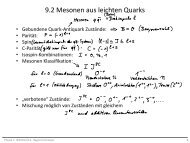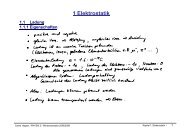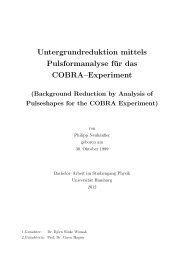Setup of a Drift Tube Muon Tracker and Calibration of Muon ...
Setup of a Drift Tube Muon Tracker and Calibration of Muon ...
Setup of a Drift Tube Muon Tracker and Calibration of Muon ...
Create successful ePaper yourself
Turn your PDF publications into a flip-book with our unique Google optimized e-Paper software.
N/dayAll Triggers vs Time12000h_timeEntries 371481Mean 1.272e+09RMS 5.801e+06100008000600040002000031.01. 02.03. 01.04. 01.05. 31.05. 30.06. 30.07. 29.08.DateFigure 5.12: Trigger rate per day for the period <strong>of</strong> data taking. The spike in thebeginning is correlated with events where almost all tubes <strong>of</strong> the detector showed anentry. Although still unexplained, the events are ignored by a noise cut <strong>of</strong> n hit < 48.the density <strong>of</strong> the drift gas has been used. In the latter case, a measurement withambient conditions similar to those at Gran Sasso has been performed. However,with this method, new systematic errors occur due to the different hardware used.Although it has been tried to account for different delays resulting from differentcabling <strong>and</strong> slow control settings, results were not completely satisfactory. In athird attempt, the actual data from Gran Sasso was taken for a calibration in spite<strong>of</strong> the low statistics. In all three cases, the resolution <strong>and</strong> efficiency were well belowthe expected values from Hamburg conditions. Spatial resolutions around 360ñmwere obtained. A worse resolution also leads to a rather large amount <strong>of</strong> falselyreconstructed tracks, especially for events containing only three hits <strong>and</strong> additionalcross talk or δ electrons. Therefore it has been decided to apply a rather harsh cuton the reconstructed data. The total number <strong>of</strong> hits may not exceed the number <strong>of</strong>hits used by the fit by more than one.5.2.2 PerformanceFig. 5.12 shows the number <strong>of</strong> triggers distributed by the trigger board each day.The rate started at a constant level <strong>of</strong> approximately 2000 triggers per day. It thenslowly reclined during the summer—an effect which is connected to instabilities <strong>of</strong>the trigger. However, it suddenly rises again to the prior value in the end <strong>of</strong> August.During this period, maintenance was done at the detector. It can thus be assumed,that this effect is correlated with the work on the detector. As will be shown in detaillater, the trigger system is not working properly <strong>and</strong> has to be replaced. Thus, thiseffect is not further studied.To check the performance <strong>of</strong> the underground operation the distribution <strong>of</strong> hitsin the single tubes <strong>and</strong> the number <strong>of</strong> events per day were investigated. Since thetrigger rate is dominated by far from r<strong>and</strong>om coincidences <strong>of</strong> the PMT’s dark noise(∼ 1 coincidence per minute), most <strong>of</strong> the events do not contain any hit tube.80





